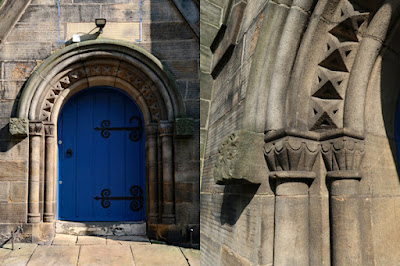 |
| The Church of St. John the Evangelist |
My walk from Grenoside to Hillsborough, to investigate the Greenmoor Rock at Birley Edge, the Kilner Way Retail Park and the Upper Don Trail and to photograph historic architecture for the British Listed Buildings website on the way, took over 4 hours and involved a walk of nearly 12 km.
For my next outing, I decided to spend an afternoon exploring the old industrial part of Sheffield around the Sheffield and Tinsley Canal and the River Don – a part of the city that I had never visited before – with the primary objective being to photograph its listed buildings.
Alighting from the No. 73 bus at the City Road/St. Aidan's Road stop, I firstly walked down to the Reggae Kitchen, where I thoroughly enjoyed one of their mixed meals – on this occasion taking the time to sit down at their table.
Continuing down City Road past mainly brick built terraced houses to Bernard Street, I stopped briefly to look at a boundary wall, where the sandstone has a high ironstone content and which I have presumed to be from the Parkgate Rock, which was once obtained from the Hyde Park quarries on Skye Edge.
Arriving at Bernard Street, I soon encountered the first building on my list to photograph, the Church of St. John the Evangelist (1838), by M.E. Hadfield, in a Gothic Revival style, with alterations c1890 by E.M. Gibbs – architects whose works I had become familiar with, when exploring other parts of Sheffield.
On the approach to the church, I stopped to take a general photograph of the unlisted polished Cornish granite Park Hill war memorial, which is in the form of a wheel cross, and the inscription on its east side, where the alkali feldspar phenocrysts - a characteristic of the Cornish and Devon granites - are clearly visible.
The church was not open and there is very little ornament on the exterior, but I had a close look at its west end, where the doorway has been designed in a Romanesque style, with dog tooth ornament to the arch and cushion capitals to the shafts.
From a distance, although slightly dirty, the generally grey coloured patina of the sandstone, with some orange variations, suggested to me that this is probably another example of very coarse grained Chatsworth Grit.
Looking more closely at the sandstone, it is indeed very coarse grained with a few little fingernail sized pebbles scattered in the stone, but there are no obvious distinct pebbly beds. As I had discovered at the East Lodge at Hillsborough Park a few days earlier, the very wild orange variation does also appear in the Loxley Edge Rock, which can be very similar to the Chatsworth Grit.
Having had a good look at the west front, I had a quick wander around the old churchyard to take a few general record photographs of the various elevations, which would be suitable for adding to the British Listed Buildings website entry for the church.
I then set off down to Cricket Inn Road, to start my exploration of Sheffield’s industrial east end, beyond Sheffield Parkway, but firstly stopped to have a quick look at the sculpture by Steve Roche, which has been set next to the footpath.











No comments:
Post a Comment